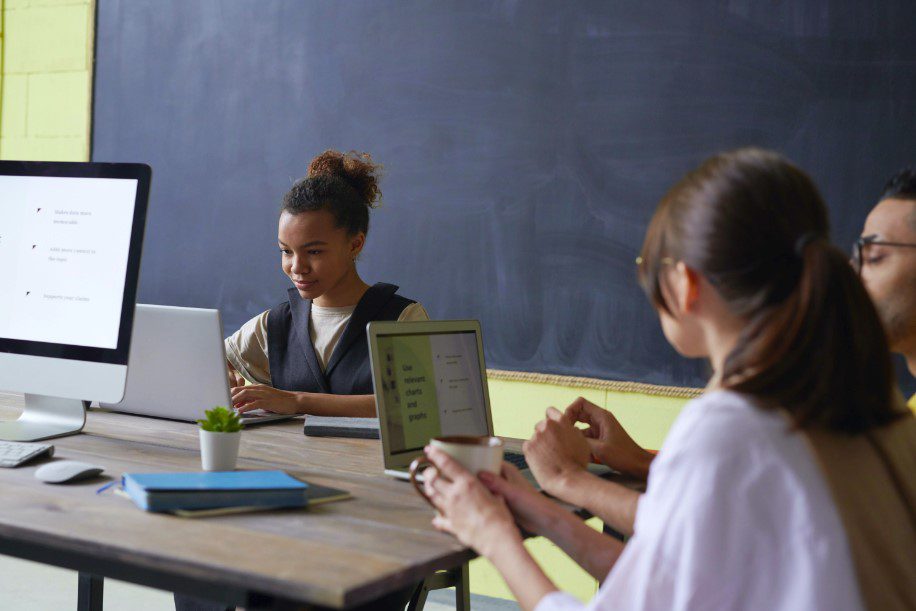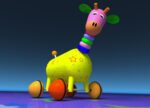The role of a teacher in the 21st century is undergoing a transformation due to the focus on student-centered education. It all stems from the high expectations and demands learners have in their own pursuit of education.
They want their teacher to marry classroom content to 21st century skills/realities, and integrate digital learning tools in the new classroom!
As traditional teaching methods give way to innovative and learner-based approaches, the modern teacher must adapt their instructional techniques to cater to the diverse learning styles, preferences, and goals of their students.
As it stands, learners today coexist with digital devices in their homes and strongly believe these should be part of their education. And they are not alone. Stakeholders in the education sector and governments around the world now believe technology should be integral in the learning environment.
Technology in education: The invasion of AI and the Metaverse

AI (artificial Intelligence), machine learning, and the metaverse have the potential to revolutionize education by creating immersive and interactive learning environments.
According to a March 2019 UNESCO working paper,
AI has started producing new teaching and learning solutions that are now undergoing testing in different contexts. AI requires advanced infrastructures and an ecosystem of thriving innovators
As subsets of Generative AI, tools such as ChatGPT and DALE-E are only a few examples of popular AI innovations. The former is an AI language processing technology, that is receiving mixed reviews from educators and language experts.
Despite its positives, many are concerned about its impact on learners critical thinking and analytical writing skills. Still, the modern day teacher can use ChatGPT in the classroom to enhance learning.
Besides AI and ML, teachers must also prepare to use virtual reality (VR) and augmented reality (AR) technologies in the classroom. Learners and teachers will be exposed to immersive learning experiences in 2D and 3D, by using platforms such as the Metaverse.
The metaverse is a digital reality that combines aspects of social media, online gaming, augmented reality (AR), virtual reality (VR), and cryptocurrencies to allow users to interact virtually.
Investopeida
Teaching and learning in virtual spaces will make education more interesting, because it will bring educators, learners and content much closer. Learners will benefit from collaborative opportunities and unique interactions with content.
By using avatars, for example, they will teleport to all corners of the world and connect with new learning experiences. The virtual learning environment will also benefit the education sector when hit hard by pandemics.
A subtle reminder is that COVID-19 stopped education in its tracks, and it will be a shame if this happens again in the 21st century!
What are the skills to teach the 21st century learners?

Well, with so much to learn and the workplaces evolving rapidly, there are no clear-cut skill sets that stand out.
This probably explains why the antiquated ‘data dumping‘ teaching model is still used today in classrooms. But a lot is changing – and pretty fast for sure. Conservatism in the classroom must pave the way for active learning and innovative ways to provide learners with relevant skills.
Where learning was a passive activity in the past, it must become active today because employers want to hire hands-on individuals with competitive working skills.
So, what is there to learn today?
In a UNESCODOC file, Tony Wagner (2010) and his team at Harvard University identified a set of competencies and skill sets that learners need for life, work, and citizenship.
The 21st century skills have been grouped into 3 categories namely;
- Learning and innovation skills
- Literacy skills
- Life and career skills
All in all, they include the following and much more:
- Critical thinking and problem solving skills
- Curiosity and imagination skills
- Agility and adaptability skills
- Initiative and entrepreneurial skills
- Effective oral and written communication skills
- Access to and analysis of information skills
- Collaboration and leadership skills
The above may not be the ultimate list of desirable skills, but remain a desirable guideline to help learners become relevant in the new century.
So, what characteristics add up to the ultimate teacher of the 21st century?

Just like the list above, there are no comprehensive characteristics that make the 21st century educator. Just as well, there are no clear-cut teaching methodologies for learning in the 21st century classroom.
Still, a few factors explained here should suffice most of the time.
Many of these are centered around personalized learning, where education is centered around learner uniqueness, interests, needs, strengths, and talent.
1. The teacher of the 21st century is flexible & adaptive
Teaching has moved away from the 20th century classroom into the learner-centered environment, for a more personalized model of learning. The old ‘top-down’ model of teaching is being cast aside, and the focus has shifted to the learner.
Part of the reason for the shift stems from the desire to take full advantage of learner abilities to make him more aware of himself. Learners can do a lot more on their own without constant supervision by the educator.
Still, the teacher is challenged to work with learners to understand their needs, strengths, weaknesses, and the influence of technology in their lives.
Learners today utilize mobile gadgets and applications as their primary sources of information, knowledge, and social discourse. However, despite these advances in educational technologies and the way learners have adapted to their changing environments, many classrooms today still employ teaching methods of the past: lecture formats, unauthentic assessments, and rote learning.
UNESDOC
Of course, the acknowledgment comes with its boons and banes. The 21st century is loaded with innovations and dependencies that keep changing, and the teacher must change with these realities.
Flexibility in the classroom necessitates realizing that learners are different, and that information and educational settings are always changing.
The modern teacher must be aware that learners too can acquire and challenge incorrect information from the teacher. It is upon the teacher to accept the changes and adapt accordingly.
Also true is the explosion of FAKE data and information, where the teacher has the uphill task to sort through this, to find out what is right and wrong information.
2. The 21st century educator is a lifelong learner
To appreciate the benefits of a lifelong learner, it is critical to understand why knowing things is no longer enough. It is equally important for teachers and learners to be intrigued by what the future holds.
Whereas your typical teacher focuses on facilitating knowledge and skill acquisition – and most of the time BASED on what he too acquired from previous teachers.
They must stay on top of the knowledge curve with new information and innovations, to produce learners who are explorers of knowledge.
To do this correctly, they must read wide and be an ardent follower of global trends in education and other disciplines. The educator, therefore, is a persistent learner, and avid reader of emerging knowledge-base and technology trends.
They should also remain informed about the following global realities:
- cultural relativism
- religious relativism
- racial diversity
- civil literacy
- etc.
The drive to remain current and informed becomes a motivating factor, which should trickle down to the learners.
3. The new educator is tech savvy
Technology is the fulcrum upon which productivity and socio-economic activities rotate in the 21st century. It is pivotal in science, finance, manufacturing, the labor market, communication, and domestic entertainment. It will ultimately take over all areas of life as the years go by.
New technology means new ways to influence productivity, communication, and learning. Technology is designed to explore and store data, improve productivity, and life.
For the Teacher, it calls for the readiness to try out new technology devices, and to discover the right balance between old learning models and emerging learning realities.
As it stands, promoting technology in the classroom is done through blended learning and other teaching methodologies.
formal education program in which a student learns at least in part through online delivery of content and instruction with some element of student control over time, place, path, and/or pace and at least in part at a supervised brick-and-mortar location away from home.
This is how Christensen Institute defines Blended Learning:
Another way to integrate technology involves the implementation of the Smart Learning Environment (SLE) to ensure that learning remains relevant.
smart learning is founded on two different types of technology: smart devices and intelligent technologies. Smart devices refer to artefacts that exhibit some properties of ubiquitous computing, including (although not necessarily) artificial intelligence; for instance, the Internet of things, wearable technology in the form of an accessory such as glasses, a backpack, or even clothing’ (p. 3). Intelligent technologies refer to learning analytics, cloud computing and AI capabilities, and are vital in capturing valuable learning data that can effectively enhance the development of personalized and adaptive learning
Regardless, the teacher has to evolve with the advancements, experiment with new hardware and software, and seek relevant components for improved learning experiences.
Better use of multimedia content in the classroom will also facilitate interest, engagement, creativity, and ultimately, better use of information learned in the classroom.
Below are some focal points for the tech-savvy teacher:
- Integrate multiple technologies in the classroom
- Integrate apps, multimedia, and e-learning tools
- Track learner progress as an attribute of SLE
- Analyze and explore technology smartly and extensively
- Discover and recognize new learning environment
- Promote the use of online virtual and other smart tools
- Get to understand Artificial Intelligence and Machine Learning better
- Integrate augmented reality(AR) and virtual realty(VR) in the classroom
- Bridge learning communities and environment
A deeper look into the workings of technology will motivate the tech-savvy teacher to design even better syllabuses for future educators and learners.
4. The new educator is a team leader & collaborator
The teacher of the 21st century no longer teaches in isolation. He collaborates with learners and other staff at school and around the world to cultivate a cohesive teaching-learning environment.
This is done effortlessly through the inclusion of technology to facilitate superior communication.
This emerging environment must be harnessed in the education sector before it makes complete sense in the workplace. The teacher must be willing to share information equally and learn from students who are ‘now‘ capable of sourcing relevant learning material on their own.
Unlike the traditional modal of learning, where knowledge was a reserve of the teacher, information today is no longer a monopoly of any one person.
Through internet repositories, collaborations, and public libraries, information is available through a click, a swipe, a tap on mobile screens, and audio-visual interactions with voice assistants.
With new innovations and variant lines of thoughts, the teacher of the 21st century should get out of his shell and,
- be a team leader
- become a collaborator
- encourage learner-centered education – cooperative learning
- is inclusive of all learners
- promote smart communication skills
- preach accountability and responsibility
- encourage digital citizenship
- create new learning avenues
- enable critical thinking and problem solving
- become visionary and inspirational
- encourage career learning and guidance
- promote hands-on knowledge and skills
- integrate the family, community, and leaders to enhance learner experience
- invite subject professionals or science experts
- cultivate sensitivity/tolerance to different cultures, race, and religions
5. The new teacher is creative & innovative
It is incumbent upon the teacher of the 21st century to instill a sense of creativity and innovation in young learners, based on their interests and motivational factors.
Creativity in teaching can help learners cultivate original thought and imagination as a gateway to 21st-century challenges. On the other hand, innovative learning prepares children to create new ideas, tools, and dimensions relevant to real life.
Most of these are cemented through interdisciplinary and applied learning, where learners are encouraged to integrate ideas and thoughts from different areas of the curriculum.
This prepares them for a broader marketplace when they leave school. They will become more than only salary earners, but innovative and creative individuals set for a much bigger world of opportunities.
The antiquated education system prepared learners for static job markets where they did not have to think beyond the month-end salary. Whereas the strategy worked for decades, the dawn of technology has dented the status quo in the second and third waves of digital transformation.
In any case, the job market is evolving exponentially with open spaces and work skills.
Out of the many, the teacher can participate and encourage some or all of the following:
- flipped learning
- playful learning
- critical thinking in solving problems
- creative collaborations
- imaginative games
- innovative thinking
- cooperative learning
- design tests
- relevant instructional scaffolding
These are helpful for established and startup firms, who are constantly looking for new ideas to create better and new products for emerging markets.
Likewise, the realities of urbanization and globalization demand that creative learners come up with smart ideas appropriate in the 21st century.
6. The 21st century teacher is a mentor & role model
Today, more than ever, learners are at crossroads in their journey towards adulthood. They wade their way through untold challenges where they can easily buckle under pressure.
The obstacles in their way include evolving global cultures, emerging morals, and the vast world of the internet. These are complicated by urbanization, street violence, substance abuse, and increasing cyber criminality.
The youth must endure these and more if they are to grow into responsible adults.
For this and other challenges, the teacher of today is meant to be someone they can lean on, to model the responsible citizen of the 21st century.
The teacher should be:
- sensitive to learner real-life challenges
- reflective of leaner emotional challenges
- sensitive to learner challenges in children
- teach ethical values
- appropriately religious and aware of divergent views
- a mentor on cyberbullying
- aware and mentor on inappropriate content online
- appropriately sociable
- a champion of physical wellness in the tech era of a sedentary lifestyle
Additional characteristics of the aspiring teacher of the 21st century:
The teacher of the new century is
- dynamic
- a storyteller
- a personalized instructor
- enthusiastic about the teaching-learning experience
The final word
In essence, the role of the 21st-century teacher demands a multifaceted skill set and an unwavering commitment to meet the evolving needs of their students in an ever-changing educational landscape. The 21st century teacher must therefore embrace technology, keep up with new information, and make the learning process active.
A Brief Q & A
Q: Who is the new teacher of the 21st century?
A: The new teacher of the 21st century is probably not a person, but a concept. It’s a teacher who embraces technology, innovation, and a student-centered approach to education.
Q: How does this new teacher differ from traditional teachers?
A: This new teacher differs from traditional teachers in several ways. Firstly, they see technology as a tool to enhance learning, rather than a distraction. Secondly, they prioritize the needs and interests of their students, and design their lessons accordingly. Lastly, they are adaptable and open to change, always seeking out new and innovative teaching methods.
Q: What skills should the new teacher possess?
A: The new teacher needs to possess a range of skills, including technological literacy, adaptability, creativity, and strong communication skills. They also need to be able to collaborate effectively with other teachers and educational professionals.
Q: How do students benefit from this new approach to teaching?
A: Students benefit greatly from this new approach to teaching, as it puts their needs and interests at the forefront of the learning process. By using technology and innovative teaching methods, students are engaged and motivated to learn, leading to improved academic outcomes. Additionally, this approach fosters the development of 21st-century skills, such as critical thinking, problem-solving, and collaboration.
Q: How can schools support the development of this new teacher?
A: Schools can support the development of this new teacher by providing ongoing professional development opportunities that focus on the use of technology and innovative teaching methods. Additionally, schools can create a culture of collaboration and experimentation, where teachers are encouraged to share their ideas and try new things. Lastly, schools can provide access to the necessary technology and resources to facilitate this new approach to teaching.





Leave a Reply